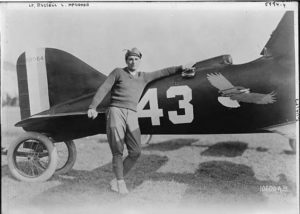29 March 1923: Flying a Curtiss R-6 Racer, serial number A.S. 68564, at Wright Field, Dayton, Ohio, First Lieutenant Russell Lowell Maughan, Air Service, United States Army, set a Fédération Aéronautique Internationale (FAI) World Record for Speed of 380.75 kilometers per hour (236.59 miles per hour). 
On 14 October 1922, Maughan won the Pulitzer Trophy Race at Selfridge Field, near Mount Clemens, Michigan, before a crowd of 200,000 spectators. He set two World Speed Record during the race with his Curtiss R-6: 330.41 kilometers per hour (205.31 miles per hour) over a distance of 100 kilometers, and 331.46 kilometers per hour (205.96 miles per hour) over a distance of 200 kilometers). On 29 March 1923, he set another World Speed Record, 380.75 kilometers per hour (236.587 miles per hour), again flying a Curtiss R-6.
The Curtiss R-6 Racers were single-engine, single-seat, fully-braced single-bay biplanes with fixed landing gear, developed from the U.S. Navy Curtiss CR. The airplane and its D-12 Conqueror engine were both built by the Curtiss Aeroplane and Motor Co., Garden City, New York.
The fuselage was a stressed-skin monocoque, built with two layers of wood veneer covered by a layer of doped fabric. The wings were also built of wood, with plywood skins and fabric-covered ailerons. Surface radiators were used for engine cooling.
The Curtiss R-6 was 19 feet, 0 inches (5.791 meters) long with a wingspan of 19 feet, 0 inches (5.791 meters). It had an empty weight of 2,121 pounds (962 kilograms).
 The R-6 was powered by a water-cooled, normally-aspirated 1,145.111-cubic-inch-displacement (18.765 liter) Curtiss D-12 dual overhead cam (DOHC) 60° V-12 engine, which was developed by Arthur Nutt, based on the earlier Curtiss K-12 which had been designed by Charles B. Kirkham. The D-12 had four valves per cylinder and a compression ratio of 5.7:1. It was rated at 415 horsepower at 2,000 r.p.m. and 460 horsepower at 2,300 r.p.m. During testing, it produced a 475 horsepower at 2,320 r.p.m. using a 50/50 mixture of 95-octane gasoline and benzol. The D-12 was a right-hand tractor direct-drive engine. It turned a two-bladed, fixed-pitch, forged aluminum propeller designed by Sylvanus Albert Reed, Ph.D. The Curtiss D-12 was 56¾ inches (1.441 meters) long, 28¼ inches (0.718 meters) wide and 34¾ inches (0.882 meters) high. It weighed 678.25 pounds (307.65 kilograms).
The R-6 was powered by a water-cooled, normally-aspirated 1,145.111-cubic-inch-displacement (18.765 liter) Curtiss D-12 dual overhead cam (DOHC) 60° V-12 engine, which was developed by Arthur Nutt, based on the earlier Curtiss K-12 which had been designed by Charles B. Kirkham. The D-12 had four valves per cylinder and a compression ratio of 5.7:1. It was rated at 415 horsepower at 2,000 r.p.m. and 460 horsepower at 2,300 r.p.m. During testing, it produced a 475 horsepower at 2,320 r.p.m. using a 50/50 mixture of 95-octane gasoline and benzol. The D-12 was a right-hand tractor direct-drive engine. It turned a two-bladed, fixed-pitch, forged aluminum propeller designed by Sylvanus Albert Reed, Ph.D. The Curtiss D-12 was 56¾ inches (1.441 meters) long, 28¼ inches (0.718 meters) wide and 34¾ inches (0.882 meters) high. It weighed 678.25 pounds (307.65 kilograms).
The racer had a range of 281 miles (452 kilometers) and a ceiling of 22,000 feet (6,706 meters).
Two R-6 Racers were built for the U.S. Army at a cost of $71,000, plus $5,000 for spare parts.
A.S. 68564 disintegrated in flight at the Pulitzer Trophy Race, 4 October 1924, killing its pilot, Captain Burt E. Skeel.
source: https://www.thisdayinaviation.com/29-march-1923/
